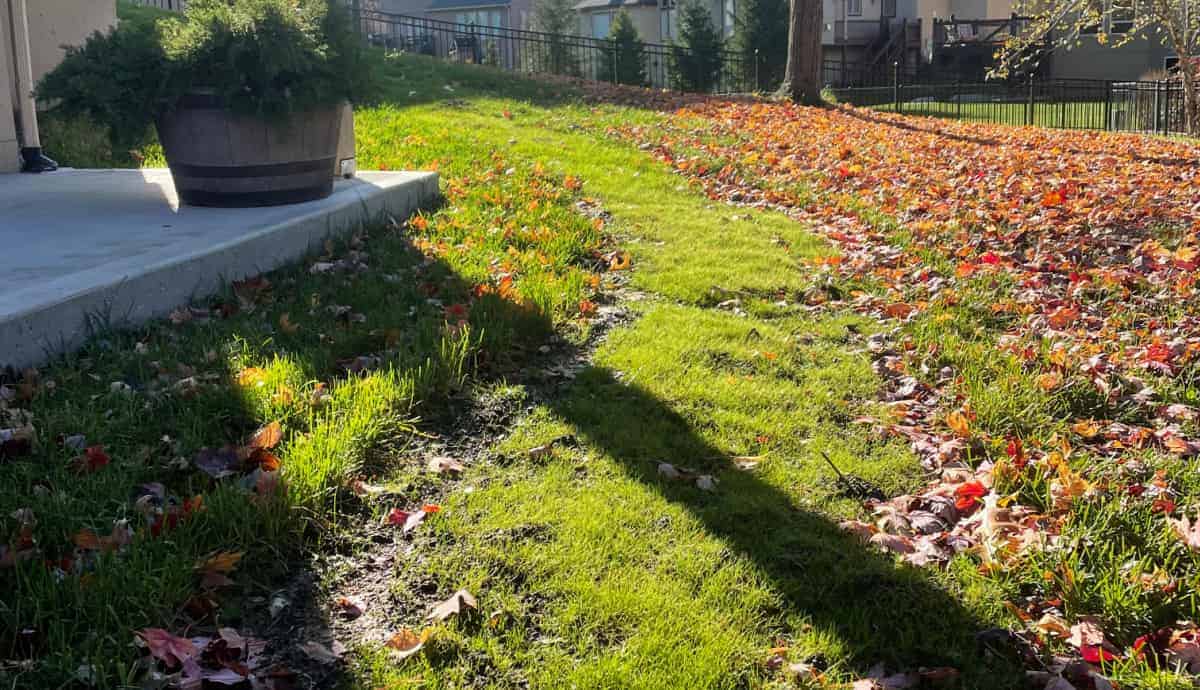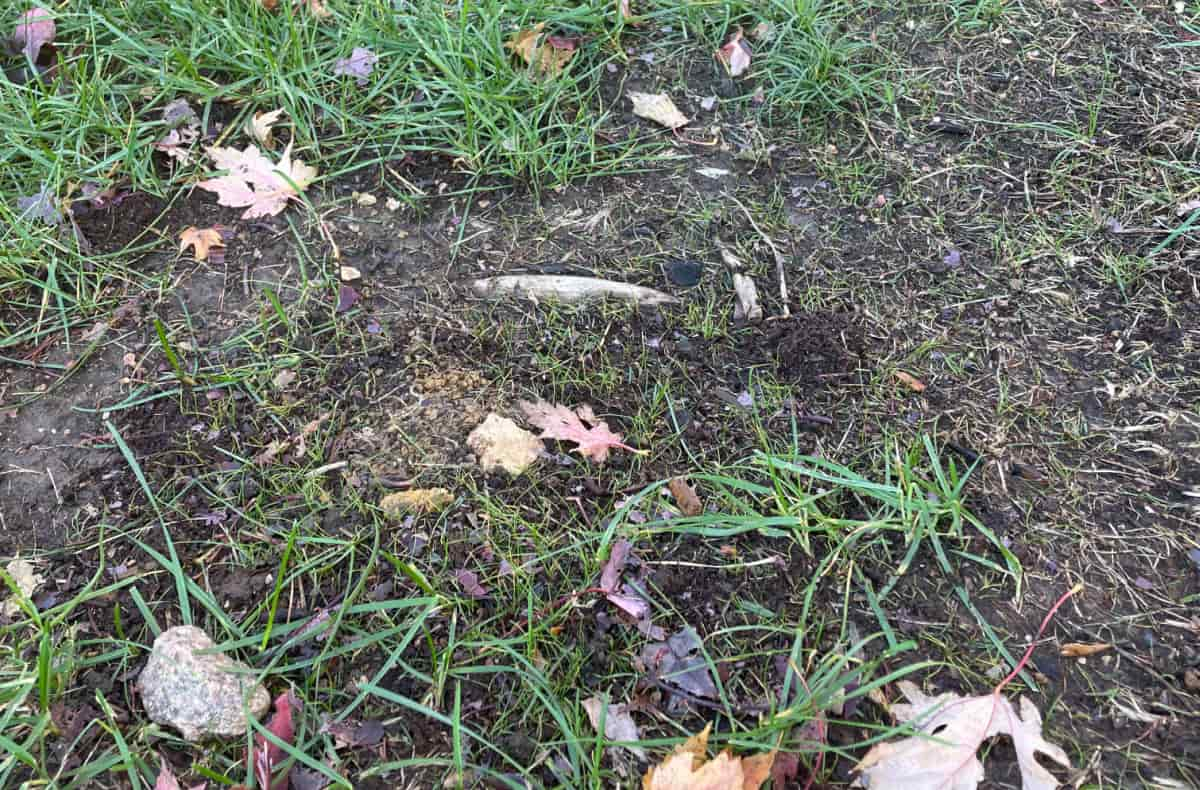How Long Should You Water New Grass
There'south nothing more aesthetically pleasing than a beautiful lawn when it comes to a home's curb appeal. While it may seem tedious, growing and maintaining a lush, green lawn is relatively simple. To reach a beautiful new backyard, the first footstep is to sympathise the nuts of seeding and lawn care.
Water new grass seed immediately after spreading. Then, water twice daily at the coolest times of solar day until the seeds sprout. Subsequently germination, h2o seedlings in one case a mean solar day for 10 to fifteen minutes each time. Keep grass moist until it's at mowing length, or 2 ½ to 3 ½ inches (half dozen.35 to 8.89 cm).
This commodity will encompass types of grass seed, full general guidelines for preparing to lay grass seed, and how to sow the seeds properly. We'll likewise talk over watering and maintenance for a nice, good for you lawn. Read on to larn more.

Things to Know Before Laying Grass Seed
Laying grass seed isn't as easy as throwing the seeds in the yard and expecting them to abound. There are several things to know before casting the seed, which nosotros'll discuss in this department.
Best Fourth dimension of Year To Found Grass Seed
Generally speaking, grass seed may exist planted at whatever time of the year, but different grasses grow better in different regions and during dissimilar seasons.
Earlier planting your grass seed, know the growing season in your area. This is the fourth dimension of year when rainfall, temperature, and hours of daylight are ideal for optimal institute growth. Mostly, it's in the spring subsequently the concluding frost.
Additionally, you'll want to recall about the type of seed you lot're planting.
Absurd-Season Grasses
These grasses grow best in cooler climates. For cool-season turfgrass, the all-time flavor for grass planting is in autumn, especially around Labor Twenty-four hours. This provides seedlings enough time to plant their root systems before the first frost without beingness scorched by the hot summer lord's day.
Absurd season grasses may also do good from dormant seeding. According to Purdue University Forest & Natural Resource, it's possible (and fifty-fifty beneficial) to establish grass seed effectually November. This gives the grass a catamenia of dormancy which might really help forestall exposure to pathogens.
Some cool-flavor grasses include:
- Kentucky Bluegrass
- Fine Fescue
- Tall Fescue
- Perennial Ryegrass
- Bentgrass
A major drawback to cool-season grasses is that subsequently dormancy planting if the temperature rises unexpectedly, the seeds will germinate and die later the weather turns common cold again.
Warm-Flavour Grasses
Warm-flavour grasses require warm conditions to thrive. In one case established, these grasses are semi-drought resistant, making them an excellent choice for drought-prone areas. Early to late bound is the best fourth dimension to plant warm-flavour turfgrass.
Some warm-season grasses include:
- Bahia
- Bermuda
- Centipede
- St. Augustine
- Zoysia
The major downside to warm-flavour grasses is that they practice non retain their vibrant, light-green color during the winter.
Soil Quality
Before tossing that seed into your thou, think about the type of soil you lot take. Soil weather condition and soil type matter, especially if you want a well-established lawn. Knowing your soil is important for choosing the blazon of grass seed that works best in your environment.
Blazon of Soil
Every area has a unlike type of soil.
- Clay soil. Information technology'southward dense and heavy and ordinarily needs the improver of nutrients before planting grass seed. Some cool-flavour grasses that grow well in dirt soil include Tall Fescue and Kentucky Bluegrass. Some warm-season grasses that thrive in clay soil are Bermuda Grass and Zoysia.
- Sandy soil. It's airy, dry out, and low-cal and is often low in nutrients, and tends to take a lower pH than other types of soil. It too doesn't hold wet. Zoysia, Centipede Grass, and Bahia Grass are fine grasses for sandy soil.
- Silt soil. Information technology is considered the best of the three because it is low-cal and has good moisture retention, and so information technology'southward ideal for most types of grass seed. It besides has a high fertility rating and rarely needs amendments.
- Loam. It'southward a mixture of the three above soil types. It contains sand, silt, and clay, and has a good water retention rate, and contains many minerals and nutrients.

Soil Condition
Some grass types are finicky virtually soil pH level. The ideal pH level is between 6 and 7. Acidic soils (sandy soils are very acidic) require the addition of ground limestone to better the soil and make it suitable for grasses.
Alkaline soils (with a pH in a higher place 7) require organic thing such as compost, composted manure, or sulfur to increase acerbity.
Ever examination the soil's pH and food levels before planting then that yous can brand whatever necessary amendments.
Soil Temperature
Before laying grass seed, soil temperatures demand to be between 55 to 65°F (12.77 to 18.33°C). Balmy temperatures in the daytime, around 60 to 75°F (15.55 to 23.88°C), are a practiced indication that soil temps are warm enough for grass seed germination. Soil temperatures beneath l°F (10°C) cause the seeds to lay dormant.
Preparation for Laying Grass Seed
Once you've determined which grass to plant and take factored in your soil quality, it'south time to prepare for sowing your grass seed.
- Mensurate the future planting area. Determine the square footage and use that data to purchase the proper amount of grass seed.
- Articulate the existing lawn where you plan to plant grass. Remove any big branches, lawn furniture, paving stones, etc.
- Loosen the soil. Soil compaction prevents seeds from taking hold. Clay soil is especially prone to compaction. Employ a rotary tiller to loosen the entire expanse.
- Rake the area. Pick up and remove any sticks, trash, debris, or erstwhile grass.
- Test the soil. Equally discussed earlier, the pH should be around 6 or 7, and the soil should have enough nutrients. If not, mix in nutrients or organic thing accordingly. Mix it in using a tiller.
- Moisten the soil thoroughly. Water the expanse to a depth of half dozen to 8 inches before sowing the grass seed.

Spreading Grass Seed
While y'all may not think so, according to the University of California Agronomics and Natural Resources, there is a proper mode to spread grass seed.
Follow these steps to get the best results:
- Separate your seeds in one-half. For example, if you purchased four pounds of grass seed, put only two pounds in a drop spreader.
- Sow the first one-half of the seeds in a vertical path. Utilize the drop spreader to move upwardly and downwards the lawn, spreading the seeds evenly. Fill the spreader with the second half of the seeds once you've finished the vertical path.
- Spread the 2nd half of the seeds in a horizontal path. Overlap the offset path, moving side to side across the k.
- Comprehend the seeds about ⅛ inch (0.31 cm) deep using a rake. Avoid sowing the seeds at significantly different depths - this could cause ane area to germinate before the other, leading to an unsightly, patchy lawn.
Related: How Often to Water New Sod
How Often To Water New Grass Seed
Enough h2o is an essential part of a happy, healthy lawn - and it's even more critical during those early on growing stages. With that said, however, information technology'southward of import to ensure that you lot're watering properly.
Frequency of Watering
Whether yous are using a sprinkler system or watering your new seed with a garden hose, equally before long equally the grass seed is sown, it'due south disquisitional that you lot maintain moisture.
If seeds are allowed to dry out, they volition not germinate - they will die. Water the grass seedlings twice daily. Continue this watering schedule until the seeds begin to sprout.
Once the grass seed starts sprouting, water once a day, just increase the time spent watering. The top two inches (five.08 cm) of soil should remain moist until the grass is fully established ii ½ to three ½ inches (half dozen.35 to 8.89 cm).
In one case the grass is established (at mowing height), water it thoroughly once the superlative inch of soil becomes dry.
How Long To Water New Grass Seed
Immediately after sowing the grass seed, h2o it for 5 to ten minutes each time. The top iii to four inches (7.62 to 10.sixteen cm) of soil should stay moist. If yous water as well lightly, the grass roots will stay shallow - and you lot'll run into the negative effects of these shallow roots once the atmospheric condition heats up.
One time the seeds sprout, reduce the frequency of watering. Withal, make sure to water for a longer period each time. Endeavor to stay around 10 to 15 minutes of water per 24-hour interval. Information technology may seem like a short fourth dimension to water then much grass seed, but you merely demand a lilliputian water to moisten the soil adequately. Likewise much water could drown the seeds, rendering them unviable.
When watering, don't focus on unmarried, pocket-size areas. Ensure that you're covering the unabridged area of the backyard with a consistent amount of water.
Related: Backyard and Deck Makeover
Conditions Weather
Mother Nature doesn't always give us the weather we need for optimal growth, but sometimes she can help usa water our grass.
Go on an eye on the weather forecast every day and lookout for loftier rainfall potential.
On days when yous receive a lot of rainfall, brand sure to gene the weather into your watering schedule. Use a rain approximate to determine how much water fell. Use that information to make up one's mind how much you lot should water, pausing your irrigation system every bit needed.
When y'all receive a small amount of rainfall, you may only demand to do a lite watering that day.
If you're receiving lilliputian to no rainfall, you'll need to h2o every twenty-four hours, at least twice per day, especially during serious dry out spells.
Sprinkler Systems
Sprinkler systems are an excellent option for maintaining the wet levels of your grass seed. However, it's important to set the sprinklers on a schedule to water but at optimal times - and if it rains, remember to turn it off!
We'll discuss what time you should h2o grass seed in the next section.
Best Time to H2o New Grass Seed
For best results, h2o grass seed starting time matter in the morn, during the late afternoon, or in the evening. During these times, the winds are calm, and the temperatures are cooler, allowing the water to be better captivated into the ground.
Avert watering at dark. Because of the lack of sunday and heat, water tends to rest in the soil and around the roots. This encourages affliction, pests, rot, and fungal growth.
How To Forestall Evaporation
As mentioned in a higher place, you tin can ensure that the water absorbs into the soil by watering at the correct times. Watering in the morning, late afternoon, or evening helps forbid evaporation, cheers to lower temperatures and less intense sunlight, especially during the summer.
Additionally, shady areas do non tend to evaporate as chop-chop equally areas exposed to full sunday. With that said, you may need to h2o areas exposed to sunlight more frequently.
How Long Does Grass Seed Take To Grow?
The amount of fourth dimension it takes for new grass seeds to abound depends on a number of factors. If yous plant grass seeds in the spring, you can expect the grass to exist well-established past early summertime. If you plant in the winter, the fourth dimension is longer due to the catamenia of dormancy. Look grass planted in November to be well-established by April.
Grass seed takes around one to three weeks to sprout when proper conditions are met. It may take an additional 3 to iv weeks earlier the grass is at mowing length. As a general rule, grass takes virtually 2 months to fully institute itself, from seeding to mowing superlative.
During the formation period, information technology's important to protect the new grass sprouts. Go along pets and animals away from the planted area and have extra intendance to reduce human foot traffic on your freshly grown grass.
Conclusion
If you want good results subsequently seeding your backyard, employ the guidelines laid out in this article. Choose the right grass for your area, ready the yard properly, ensure the soil is platonic, and maintain a frequent watering schedule.
Once established, your lush, green lawn will be the talk of the town. Don't be surprised when your neighbors come by asking you lot for advice on their yards!
RELATED READING
-
What is the Best Spray Paint for Metal Outdoor Patio Furniture?
-
What Happens When Outdoor Rugs Get Wet- Quick Tips & Advice
-
An Easy Guide to Painting Outdoor Patio Cushions
-
Easy Instructions to Spray Paint Outdoor Furniture

How Long Should You Water New Grass,
Source: https://www.loveourreallife.com/how-often-when-water-new-grass-seed/
Posted by: crousesligized56.blogspot.com



0 Response to "How Long Should You Water New Grass"
Post a Comment